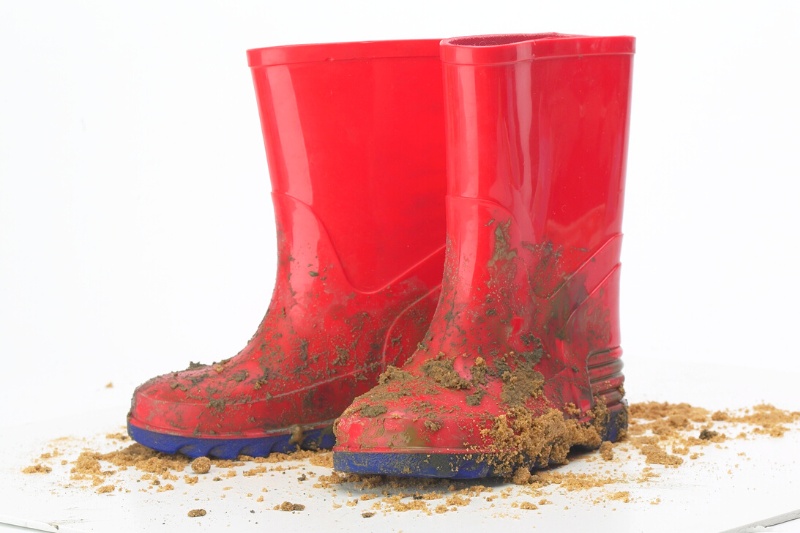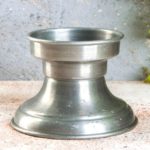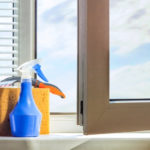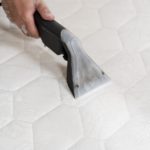Wellies are made for jumping into ankle-deep puddles, splashing through mini bogs, and tackling mud-ridden hikes!
But to get years of use out of a single pair of wellington boots, you’ve got to clean and maintain them.
If you don’t bother taking care of your rubber boots, they’ll become super stinky, the muck they’re caked in will be extremely hard to remove, and eventually, the boots will start to crack!
It’s not exactly ideal when you need the shoes to keep your feet dry as you splash through pools of water and fields of sludge.
So, what is the best way to clean wellies? Find out below!
Things to Remember When Cleaning Wellies
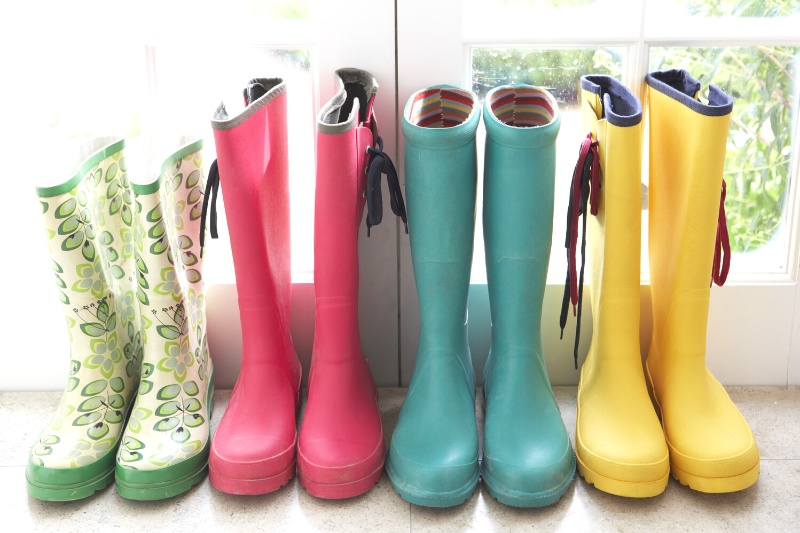
- Don’t use strong chemicals to clean wellingtons because the solution(s) could break down the glue holding the rubber together, damage the material, or discolour the wellies. In most cases, some lukewarm soapy water is all you’ll need to wash your wellingtons.
- Keep bleach away from wellies as it will discolour the material and damage the rubber.
- Don’t use hard cleaning tools to clean mud off wellingtons. Tools like scourers and wire brushes will scratch the material. Stick to using soft to medium bristled brushes and cloths.
- Leave wellingtons to dry naturally. But don’t leave the rubber boots in direct sunlight, as this can dry them out and cause cracking.
- Don’t put wellies in the washer or dryer. These cleaning and drying methods can damage the rubbery material, warp it and make the boots unwearable.
- Always read the tag on your wellies to see how they should be cleaned.
- After you’ve worn your wellies, leave them to air out so you don’t get a build-up of bad smells inside the boots.
- Try to wear absorbent socks when wearing your wellingtons. The socks should absorb a lot of foot sweat and, in turn, reduce the amount of odours and sweat that plague the inside of the rubber boots.
- Try to stay on top of the cleaning so dirt doesn’t build up. In turn, your rubber boots will be easier to maintain!
- Always clean from the top of the welly to the bottom so the dirt falls downward.
- Remember to protect your workstations with newspapers and old towels. You’ll probably drop lots of mud, dust and general grime onto surfaces as you clean, so protect them from the muck! And if you do drop mud/general waste over the floor/counter as you clean, remember to brush/wash the surface afterwards.
How to Clean the Outside of Wellies
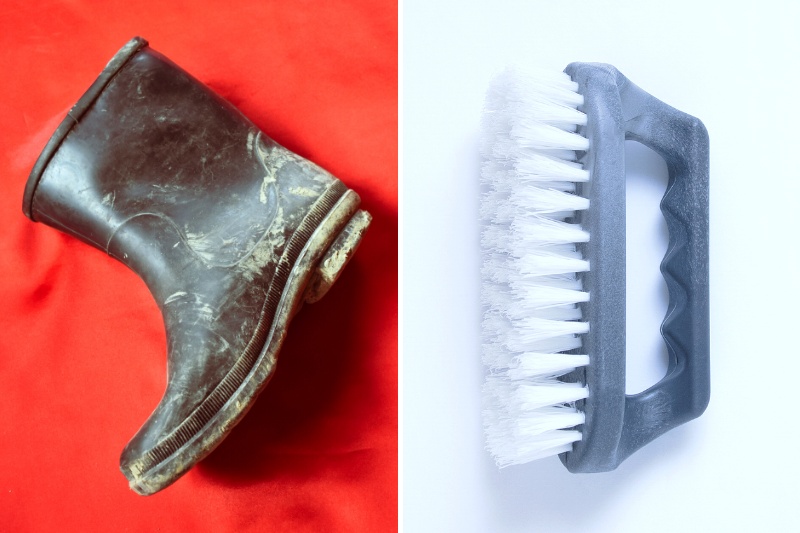
General cleaning
To clean the outside of a wellington boot, follow these steps:
- Remove your wellingtons.
- If the muck is still wet on the boots, hold each welly under the tap and rinse any loose debris, like mud, off the surface. Try not to get water inside the boot.
- If the mud or grime has dried onto the surface, use a soft to medium bristled brush to gently rub the dirt off each rubber boot. A toothbrush works just as well.
- Rub the treads (the bottom part of the wellies) on both boots clean with the brush. Take your time doing this, as some treads have intricate patterns and grooves that can trap debris.
- When you’ve brushed all the muck off a single welly, wipe the whole surface down with a warm, damp cloth. Don’t soak the boot.
- Repeat Step 5 for your second boot.
- Move on to the drying phase or clean the inside of the boot.
Heavy stains
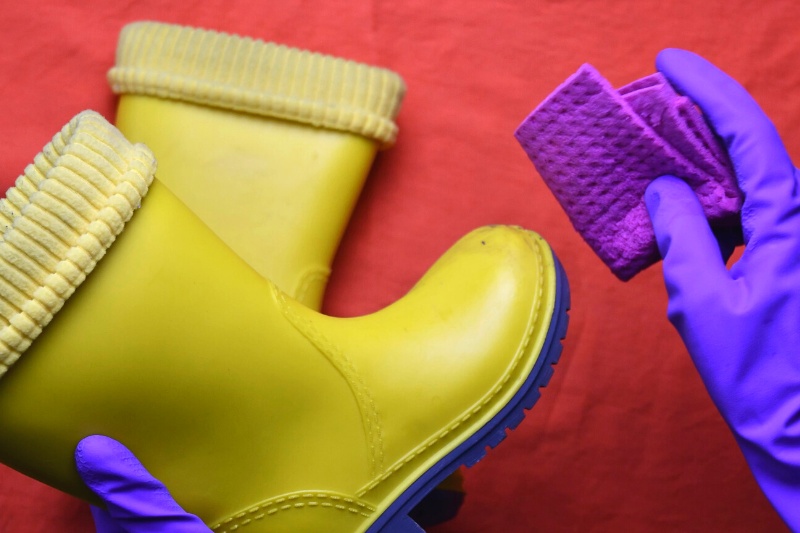
If the rubber boots are stained, usually by salts and extra muddy water, clean them using the method above but use warm soapy water instead.
Simply fill a bowl with warm water and a few drops of washing-up liquid, dip a microfibre cloth into the water, wring it out and rub the boot from top to bottom.
By cleaning from the top of the boot to the tread, all the dirt will run down the outside of the boot.
When you’re done, rinse the boots under the tap to remove the suds and any remaining dirt. Then move on to the drying phase.
‘Blooming’ worries
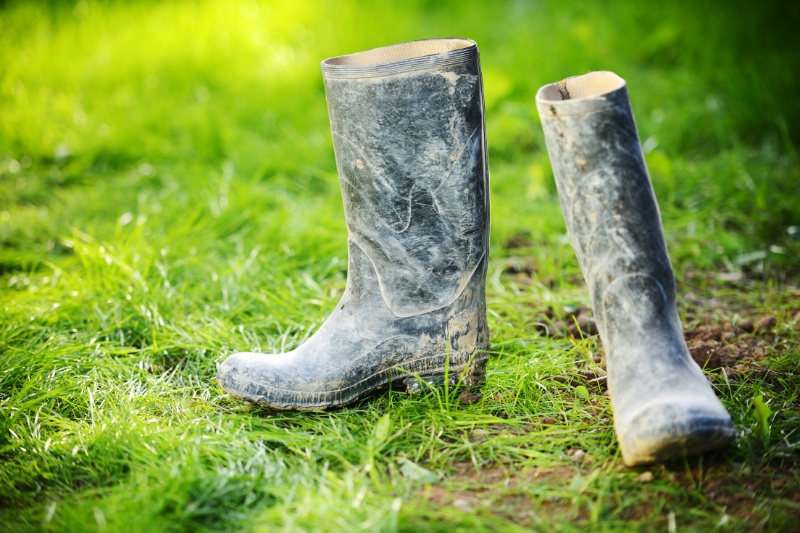
Natural rubber wellies can sometimes have white, dusty marks on them. And this ‘bloom’ that you see is usually caused by a reaction between the rubber and the environment it’s in.
For example, in hot, humid environments, insoluble particles will rise to the surface of the rubber wellingtons and leave white, dusty marks on the boots.
If your wellingtons have succumbed to the ‘blooming’ effect, don’t worry. This is quite natural and doesn’t mean your wellies are bound for the bin. It actually means that your wellingtons are made from a quality rubber!
The blemishes can, however, be removed fairly quickly. And although the stains are an eyesore, they don’t hinder the wellingtons in any way.
To cure a ‘blooming’ issue, first, clean your boots (remove the excess dirt), then wipe a damp, soapy cloth over the whole surface from top to bottom to remove the ‘blooming’ blemishes.
In addition, some say that you can dab a little olive oil onto a cloth and massage the solution into the ‘bloom’ marks on your wellies to remove the powdery mess.
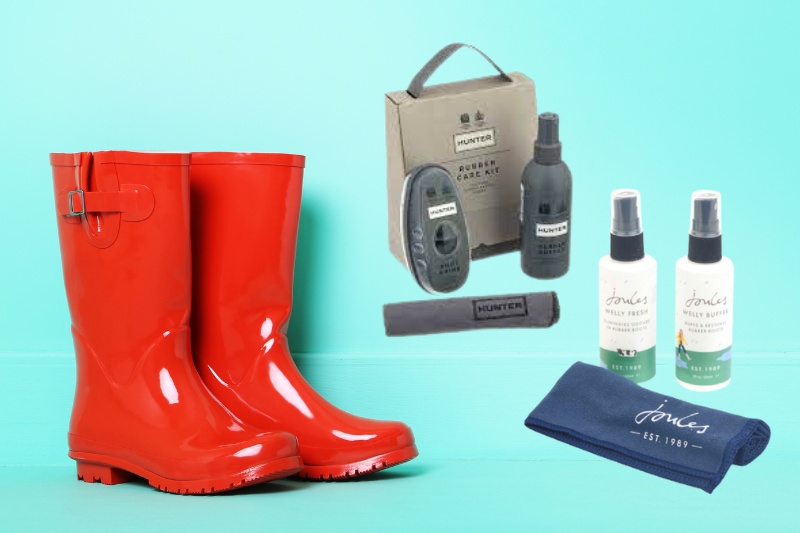
But you try this method at your own risk because it doesn’t always work out as well as you’d like it to, and can make the rubber very slipper! So definitely keep the oil away from the treads.
If you’re having trouble removing ‘blooming’ marks, pick up a rubber repair kit to restore the shine to your wellies!
A rubber cleaning kit usually comes with some cleaning spray and cloths that you can use to buff the wellies’ surfaces clean!
If you have a pair of Hunter wellies, you can purchase Hunter’s very own Rubber Repair Kit right now! The pack comes with everything you need to eradicate those unsightly marks from your boots.
Similarly, Joules do their own version called the Welly Care Set. It features the same kind of care products and can buff, restore shine, and neutralise odours in rubber wellies!
How to Clean the Inside of Wellies
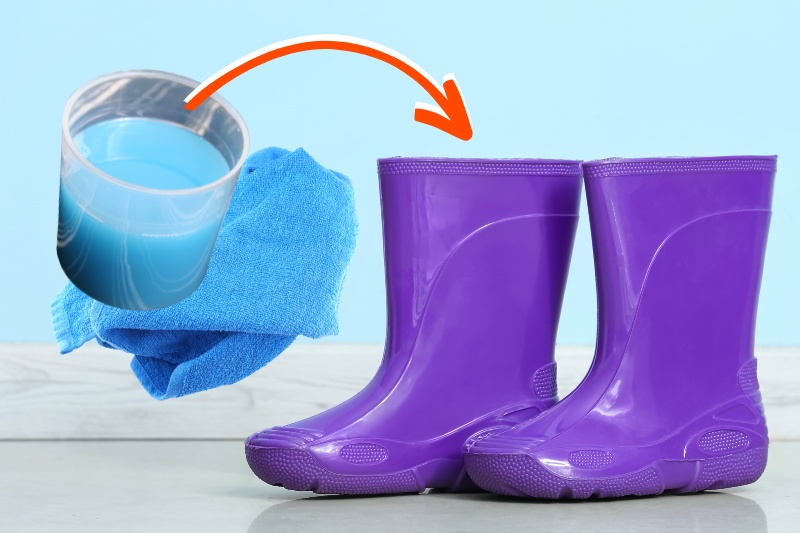
The insides of your wellingtons are exposed to sweaty feet, as well as water and grime almost every time you wear the boots. So naturally, this area will become stained and scented with time.
To clean the inside of a wellington, follow these steps:
- Fill a bowl with a teaspoon of liquid biological laundry detergent and warm water – make sure the detergent contains enzymes because you need these to break down the grime.
- Soak a clean microfibre cloth in the water.
- Wring the cloth out so it’s just damp.
- Wipe every inch of the inside of the welly with the damp cloth – remember to dip and wring the cloth out during this time.
- Repeat for the second boot.
- Fill a second bowl with fresh warm water.
- Grab a second microfibre cloth and dip it into the fresh warm water.
- Wring the cloth out.
- Wipe every inch of the inside of the welly with the damp cloth to remove excess detergent.
- Move on to drying your rubber boots.
In addition to the above, you could spray a water and white vinegar mist inside your wellies every couple of wears to help keep smells and bacteria at bay.
And for heavily scented rubber boots, drop a quarter of a cup of bicarbonate of soda straight into each boot and leave them overnight.
By morning, the bicarbonate of soda should have neutralised the stench for you. Just remember to empty the powder out before you put your feet in the boots.
How to Dry Wellies
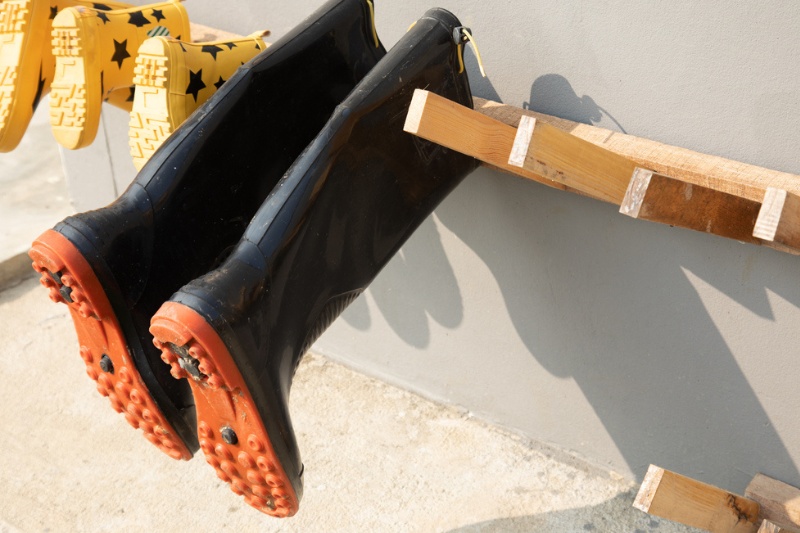
Don’t tumble dry your wellies because the excessive heat and spinning motion can warp, strain, and permanently damage (crack) the rubber boots and their soles.
And as tempting as it may be, don’t place your wellingtons on top of a radiator or any other kind of heater to dry them because the heat, again, can damage the material.
Dry your boots using the following method:
- Stuff both wellingtons with newspaper or a few small hand towels. The paper/towel will absorb the moisture.
- Wait an hour, then remove the wet newspaper/towels and replace them with fresh newspaper/towels.
- Repeat Step 2 over several hours.
- Leave the boots to air dry naturally.
- Don’t leave the rubber boots in direct sunlight.
- Check on the wellies throughout this time and store them when both the outside and inside are completely dry. See below for more information on storing wellies.
How to Store Wellies

Cleaning and maintaining your wellingtons are essential activities. But storing wellies correctly will also protect them and help them to stick around for longer.
Check out the storage tips below:
- Always store wellies in a cool area.
- Make sure your wellingtons are placed in a dry area – don’t leave them outside in the rain, for example.
- When your boots are no longer in use, roll a hand towel up and stuff it inside one of the boots so the boot doesn’t sag or lose its shape when it’s not in use (repeat for the second boot). You can also use a welly boot stand to hold the boots in place.
- Pop a scent sachet in each welly when you’re no longer using the boots, so they stay nice and fresh ready for the next wintery season.
Can Wellies Go in the Washing Machine?
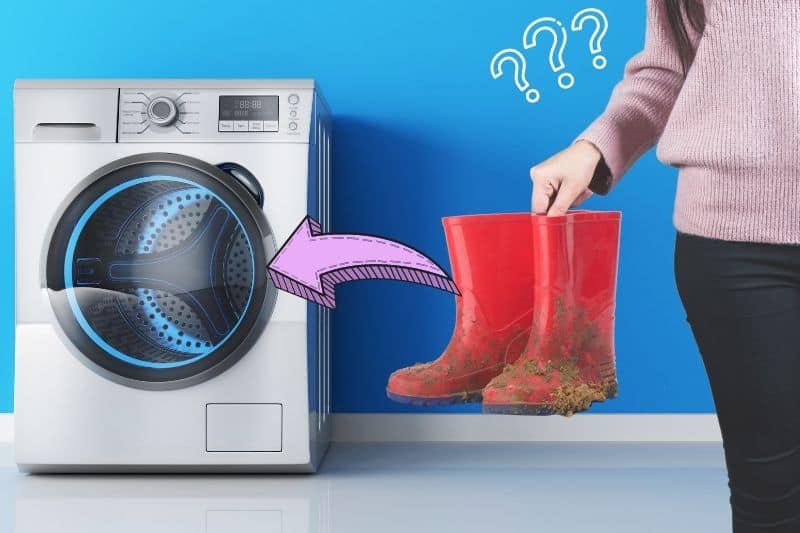
As a rule, you shouldn’t put wellingtons in a washer because the intense heat and agitation will damage the rubber boots (crack and scuff) and remove any other coating the wellies have (lose their waterproof coat).
The damage in question is usually permanent and cannot be reversed, so avoid cleaning your boots in a washer.
On the topic of machine-cleaning wellingtons, you shouldn’t put wellies in a tumble dryer either. Again, the intense heat and movement can warp and damage the rubber boots, making them unwearable.

Bethan has a passion for exploring, reading, cooking and gardening! When she’s not creating culinary delights for her family, she’s concocting potions to keep her house clean!
